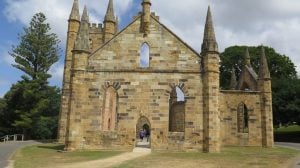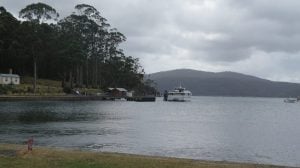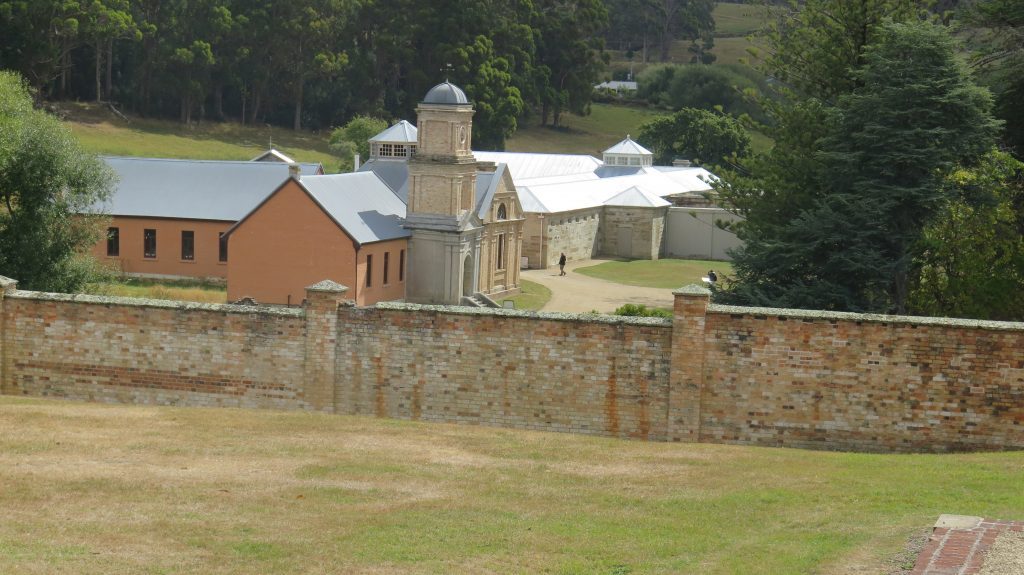21 February 2014
View from the Guard Tower looking toward the Penitentiary
I could hear heavy rain during the night, and woke up to a bleak morning with a gusty wind still blowing. There was no need to rush today, so we were able to have a casual and delicious breakfast of (for me) muesli with fruit compote and yogurt (my favourite) and we both enjoyed thick toast with jams produced at the Norfolk Bay Convict Station. A healthy start to what we know will be a busy day and lots of walking.
It was only a short drive to Port Arthur, and although we arrived fairly early the car parks were filling up and coaches had arrived. We had to decide what we wanted to do during our visit, as this dictated our entry fee – as their computers were down it slowed the process as the work had to be done manually. We decided on the Silver entry which entitled us to a short cruise on the Maruna, but did not include guided tours on the Isle of the Dead, or Port Puer Boys’ Prison or lunch.
Looking toward the jetty and the Maruna
To fill in time before our 11.40am cruise, (and by this time wearing our wind jackets) we initially joined a large crowd on a guided tour, however the windy weather made it difficult to hear (unless you were right next to the guide) and with the chatter of very young children, and people who just can’t do anything without letting the world know what they are doing on their mobile phone (maybe I’m becoming a grumpy old woman!), the exercise became a challenge. Our decision to hire iPods to hear audios of all of the points of interest was a good one, so we decided to give the guided tour a miss and do our own thing with the iPod audios, a much better option as it turned out.
We first set off for the famous Penitentiary (the image most people relate to Port Arthur). This building was initially a flour and mill granary but as the numbers of convicts increased it was converted to a four-storey Penitentiary. Most of the building was badly damaged in fires in 1895 and 1897, vandalism and time further increased the damage – however I have heard there are now recent hints that the building will be restored.
Many of the original buildings have either disappeared or remain skeletons, however it is an eerie experience to walk among the remaining buildings and imagine what life must have been in what was once a very busy port, with a ship building industry.
A prime position for the Commandant’s Cottage
Some of the buildings are open for inspection, the Commandant’s Cottage is of course in a prime position overlooking the entire settlement and the Port, and it was interesting to see the contrast between this cottage, and the accommodation of the convicts.
It was approaching the time we were to leave for our cruise, so we walked around to the ferry to board the Maruna. I was amazed at the number of people who visited the settlement, a lot of them on coaches – it was a large vessel but packed to the rafters! Our guide told us about Point Puer where boys from the age of nine were imprisoned from 1834 to 1849, the first purpose-built juvenile reformatory in the British Empire. The boys at least received an education while some were given the opportunity of trade training (such as ship building).
We then learned about the Dockyard where ships had been built for a number of years (and our guide recommended a walk to see the Dockyard up close), we then stopped at the Isle of the Dead and passengers who were to go on this tour disembarked. This is the island visible from Port Arthur where the convicts were buried.
On return to the ferry pier we chose to walk to The Dockyard to find out more about David Hoy, a Scottish shipwright who had moved with his family to Port Arthur between 1834-1848 to set up a ship building industry. This was very successful, and in its 15 years of operation produced 16 large decked vessels and about 150 small open boats. There is a 25 metre long sculpture sitting in one of the Dockyard’s two slips, evoking the scale of the ships that were made here.
Ship builders in Hobart and other ports could not compete with Port Arthur (with its cheap convict labour) and the government was asked to step in, to the point that the industry then stopped in Port Arthur. The convicts later erected a large brick oven on the waterfront to bake shells to make lime that was an essential ingredient for building construction at Port Arthur.
Sculpture evoking the scale of ships made in Port Arthur, with the Shipwright’s house in the background.
 All this exploring made us hungry, so we returned to the Felons Cafe for lunch, listened to some more interesting audios on our iPods, and prepared for more walking around the site. This time we passed The Church (1837), built to contain 1100 people but now only a dominant shell (right), the Junior Medical Officer’s cottage (1848), The Roman Catholic Chaplain’s House (1843) and the Visiting Magistrate’s house (1847). Many of the buildings have disappeared, some are mere skeletons.
All this exploring made us hungry, so we returned to the Felons Cafe for lunch, listened to some more interesting audios on our iPods, and prepared for more walking around the site. This time we passed The Church (1837), built to contain 1100 people but now only a dominant shell (right), the Junior Medical Officer’s cottage (1848), The Roman Catholic Chaplain’s House (1843) and the Visiting Magistrate’s house (1847). Many of the buildings have disappeared, some are mere skeletons.
Our visit to The Separate Prison (1849) was quite confronting – this is where convicts were locked up for 23 hours each day in single cells where they ate, slept, and worked, with just one hour a day allowed for exercise, alone, in a high-walled yard. The convicts were forbidden to talk, sing, whistle, dance or make any sound at all. It was designed to deliver a new method of punishment, of reforming the convicts through isolation and contemplation.
The confronting Separate Prison adjoining the Asylum
By now the sun was coming through the clouds more often, although the wind was still quite cool. The sombre weather today, we thought, was compatible with our emotions as we surveyed what had been quite a brutal penal settlement. Although we did not see the memorial to the 35 people killed by Martin Bryant on 28 April 1996, they were certainly on our mind that day.
 The entire settlement site is much bigger than we imagined and requires time, and stamina, to walk around to see everything. As we were heading back toward the main entrance an empty passenger buggy stopped and the driver kindly offered to give us a lift – not sure if he thought we weren’t going to make it, or just that he had an empty vehicle (I would like to believe the latter!), but it was kind of him to pick us up and save us one last walk, and he gave us even more information about the Port on the way back.
The entire settlement site is much bigger than we imagined and requires time, and stamina, to walk around to see everything. As we were heading back toward the main entrance an empty passenger buggy stopped and the driver kindly offered to give us a lift – not sure if he thought we weren’t going to make it, or just that he had an empty vehicle (I would like to believe the latter!), but it was kind of him to pick us up and save us one last walk, and he gave us even more information about the Port on the way back.
After leaving Port Arthur we took the road to White Beach where we walked 115 steps down (and up) to see the Remarkable Cave. Here the surf bursts through a deep cave under the high cliff, and surges out the other side. It was a real adventure to climb down the stairs into the depths of the chasm and watch the surf break through in front of us – got some great photo shots!
The Remarkable Cave, worth the walk down (and up) 115 steps
We returned to our accommodation via Nubeena where we stopped at the Bakery for afternoon tea, then back to Norfolk Bay. We had booked for dinner at the Lufra hotel and apartments (constructed by Reg Ansett a number of years ago) looking over Pirate Bay, and had a delicious dinner watching the day come to an end, and the fishing boats bobbing on the Bay, collecting their crayfish pots – a perfect end to a busy and energetic day
Tomorrow we return to Hobart – only two more sleeps before we head home.









Ade & Ros
Hi Lyn & Pete
What a wonderful commentary for your trip. You have certainly captured the detail and history ! Brings back fond memories of our comparatively short tour of Tassie back in late 2009, and gives us an appetite to return and visit the places we would have liked to but ran out of time. We were not nearly as organised as you have been. We made some advance bookings but “winged it” for a good part of our trip.
Safe trip home and we look forward to catching up soon.
Love from Ade & Ros
xxxx
Thank you both, I’m pleased you have restored your memories of Tassie, and hope you do decide to make another trip to see what you missed last time xxx
Danielle Sim
Thanks Lyn for the wonderful detail and fabulous photos of Tassie. Pete and his mum Carol and I are all heading down that way next February for a couple of weeks, so we are looking over your website very carefully!! I am glad we have many of the things listed that you have already done. The notes about the restaurants is very helpful too. Love from Danielle Sim
Thanks Danielle, you will have a wonderful time in Tasmania, it is so beautiful!